Refrigerating and Air Conditioning Condensers and Receivers – Household
An after-market, replacement air-cooled condenser manufactured for household, cabinet refrigerators and ice cream cabinets using anhydrous sulphur dioxide refrigerant. Fabricated with steel frame, 1/4inch steel tube and soldered, serpentine fin in heavy tin plate, with brazed, extended, sealed, 1/4 inch copper pigtails and SAE flare nuts, supplied by Kelvinator of Canada, London Ontario to their dealers, 1938.
Technical Significance:
Kelvinator of Canada, in their 1948 parts catalogue [see bibliographic reference] show a series of such replacement condensers for ice cream cabinets and domestic refrigerator applications. Condensers were “consumables” in the period when the major refrigerant in use was sulphur dioxide, highly corrosive by nature. Much construction was in tinned steel with tin coatings subject to break down.Considerable damage was also the result of fan blades coming loose on their motor shafts and cutting through the condenser wall. The effect for the owner was both catastrophic and chaotic. The machines would contain sufficient noxious refrigerant to quickly fill the house or store, leading to frantic search for men to remove the offending unit and a call to the refrigeration service man, often several hours away.
The serpentine, soldered fin construction represented a 2 nd or 3 rd generation of fin engineering, with higher conductivity and thermal performance, to earlier generations with simple un-secured plate fins. The manufacturing process for producing the fins and soldering them in place was a mark of the increasing sophistication of Canadian manufacturing methods, in place by the end of the 1930’s.
As manufacturing methods evolved the Canadian industry would move to non-ferrous tube and fin construction [copper], see code no. 6.02-7, and eventually to non-corrosive refrigerants, including methyl chloride and Freon 12. But for now this construction genre remained as the state of the art, an important snapshot in time.
See also items 6.01-2, 6.01-3, 6.02-7, 6.02-8


